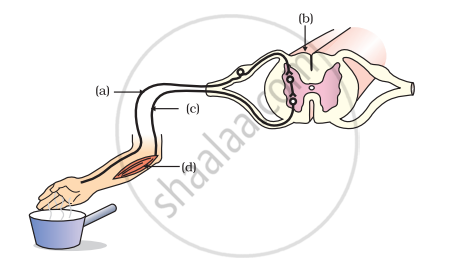Advertisements
Advertisements
प्रश्न
In the given diagram:
- Name the parts labelled A, B, and C.
- Write the functions of A and C.
- Reflex arcs have evolved in animals? Why?

उत्तर
- A: Sensory neuron or Nerve
B.: Relay neuron or Interneuron
C: Effector - The functions of A and C are as follows:
A: The sensory neuron conducts the nerve impulses towards the Central Nervous System (CNS). The CNS is comprised of the brain and the spinal cord.
C: The effector organ shows response by contracting or secreting a product. - Animals have evolved reflex arcs because the brain's reasoning process is too slow for them. Many animals lack the intricate neuronal network required for thought, or have relatively few of them. Reflex arcs have probably developed as an efficient means of surviving in the absence of actual cognitive processes. However, reflex arcs continue to be more effective for fast responses even after the development of complex neuron networks.
संबंधित प्रश्न
A part of the body which responds to the instructions sent from the nervous system is called ____________.
Reflex arc is formed by:
Which of the following statements are true?
- Sudden action in response to something in the environment is called reflex action
- Sensory neurons carry signals from spinal cord to muscles
- Motor neurons carry signals from receptors to spinal cord
- The path through which signals are transmitted from a receptor to a muscle or a gland is called reflex arc
Label the parts (a), (b), (c) and (d) and show the direction of flow of electrical signals in the given figure.

What are reflex actions? Give two examples. Explain a reflex arc.
From where the following nerves arise.
Auditory nerve
Which one is NOT a reflex action?
Sensory nerve of a reflex arc carries information from the receptor cells to the ______.
Arrange and rewrite the terms in group in the correct order to be in a logical sequence, beginning with the term that is underlined:
Effector, Receptor, Motor neuron, Sensory neuron.
Name the type of nerve which has the fibres of both sensory and motor neurons.
